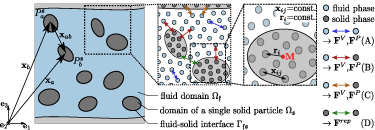22. Multi-scale analysis of fully-resolved fresh concrete ow using mesh-free SPH
Principal investigator(s) – PI
- Prof. Dr.-Ing. Holger Steeb
Universität Stuttgart, Institut für Mechanik (MIB)
Researcher(s) in-charge – RI
- M.Sc. Daniel Rostan
Universität Stuttgart, Institut für Mechanik (MIB)
Researcher(s) associated – RA
- M.Sc. Nadine Kijanski
Universität Stuttgart, Institut für Mechanik (MIB) - M.Sc. David Krach
Universität Stuttgart, Institut für Mechanik (MIB)
Term
2021-2024
Project identifier
Deutsche Forschungsgemeinschaft (DFG) – Grant No. WI 663 1911/25-1, Project No. 386871659
Project Description
We aim to model and analyze concrete-like suspensions on multiple-scales using micro-scale-resolved direct numerical simulations in course of the project. The knowledge about rheological properties of these materials is of great interest for increasing complexity of construction projects where fresh concrete has to be pumped over large distances and heights.
Considering fully resolved flow for suspensions, with a carrier fluid and resolved solid aggregate content, phenomena that arise through the multi-scale nature of fresh concrete like shear-induced particle migration and formation of lubrication layers can be reproduced. This is of relevance for engineering tasks to determine control parameters as the required pumping pressure due to its dependency on the thickness of the lubrication arising in the suspension. Additionally, a better understanding of the effective rheological behaviour on the micro- and nano-scale of suspensions can be established to provide insights about the morphology.
For the Direct Numerical Simulation (DNS) on multiple scales we take advantage of the Lagrangian character of the Smoothed Particle Hydrodynamics (SPH) method to accurately map large deformations in the flow behavior and to elaborate on the complex motion of single particles. To efficiently solve the numerically discretized Partial Differential Equations (PDEs) we use the highly parallelized self-developed software package HOOMD.sph, which is based on the molecular dynamics package HOOMD-blue (Highly Optimized Object-oriented Many-particle Dynamics).
Our implementation is capable of both, Newtonian and non-Newtonian carrier fluids in combination with spherical and and non-spherical solid aggregates. Thus, it provides a solid basis that allows to model a very wide range of problems in the current state.
The project is organized in work packages, which will be processed in a step-by-step manner. First our software package will be migrated to large-scale CPU- and GPU-Clusters to expand the studies previously conducted on dilute flow for solid particle-laden flow to the simulation of much more dense suspensions with up to 10^9 particles. In the next step the simulations will be extended from spherical and elliptical to arbitrary shaped solid aggregates based on $\mu$-XRCT scans of grain- and shape-distributions used in experiments by other groups of the SPP 2005. With the validation of our model in the limitation of trivial geometries in these steps, we are able to take the focus to more sophisticated geometries. Thereby we can capture processes occurring throughout applications, e.g. the simulation of a split-bottomed cell, in a further step. This will enable us taking a deeper look on local shear bands, especially concerning their dependence on the underlying rheology of the carrier fluid and the immersed particles. Results obtained throughout our numerical studies are highly beneficial for other projects within the SPP 2005 and will strengthen cooperation between the different groups by potential comparisons of numerical and experimental data.

Schematic of our suspended particle SPH model with the occurring short-range particle ninteraction forces

Evolution of our work packages from spherical to arbitrary shaped solid aggregates with increasing complexity of the considered geometries
